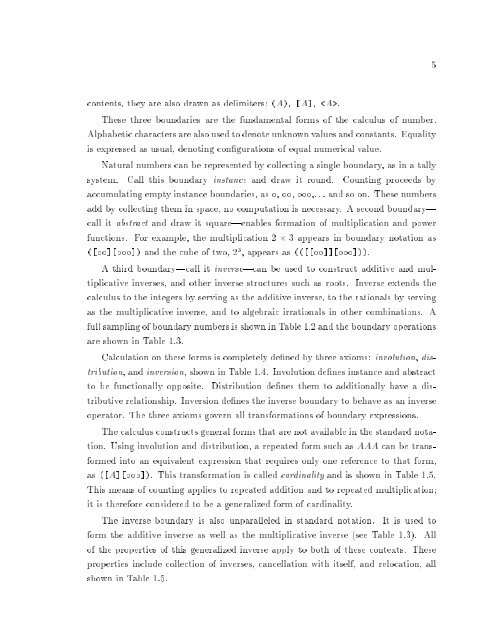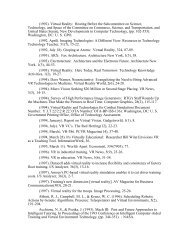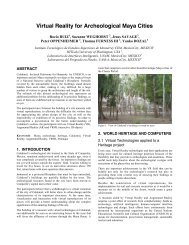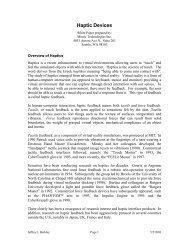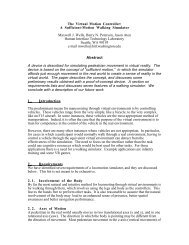A Calculus of Number Based on Spatial Forms - University of ...
A Calculus of Number Based on Spatial Forms - University of ...
A Calculus of Number Based on Spatial Forms - University of ...
Create successful ePaper yourself
Turn your PDF publications into a flip-book with our unique Google optimized e-Paper software.
5<br />
c<strong>on</strong>tents, they are also drawn as delimiters: (A); [A]; :<br />
These three boundaries are the fundamental forms <str<strong>on</strong>g>of</str<strong>on</strong>g> the calculus <str<strong>on</strong>g>of</str<strong>on</strong>g> number.<br />
Alphabetic characters are also used to denote unknown values and c<strong>on</strong>stants. Equality<br />
is expressed as usual, denoting c<strong>on</strong>gurati<strong>on</strong>s <str<strong>on</strong>g>of</str<strong>on</strong>g> equal numerical value.<br />
Natural numbers can be represented by collecting a single boundary, as in a tally<br />
system. Call this boundary instance and draw it round. Counting proceeds by<br />
accumulating empty instance boundaries, as ; ; ;:::and so <strong>on</strong>. These numbers<br />
add by collecting them in space, no computati<strong>on</strong> is necessary. A sec<strong>on</strong>d boundary|<br />
call it abstract and draw it square|enables formati<strong>on</strong> <str<strong>on</strong>g>of</str<strong>on</strong>g> multiplicati<strong>on</strong> and power<br />
functi<strong>on</strong>s. For example, the multiplicati<strong>on</strong> 2 3 appears in boundary notati<strong>on</strong> as<br />
([][]) and the cube <str<strong>on</strong>g>of</str<strong>on</strong>g> two, 2 3 , appears as (([[]][])):<br />
A third boundary|call it inverse|can be used to c<strong>on</strong>struct additive and multiplicative<br />
inverses, and other inverse structures such as roots. Inverse extends the<br />
calculus to the integers by serving as the additive inverse, to the rati<strong>on</strong>als by serving<br />
as the multiplicative inverse, and to algebraic irrati<strong>on</strong>als in other combinati<strong>on</strong>s. A<br />
full sampling <str<strong>on</strong>g>of</str<strong>on</strong>g> boundary numbers is shown in Table 1.2 and the boundary operati<strong>on</strong>s<br />
are shown in Table 1.3.<br />
Calculati<strong>on</strong> <strong>on</strong> these forms is completely dened by three axioms: involuti<strong>on</strong>, distributi<strong>on</strong>,<br />
and inversi<strong>on</strong>, shown in Table 1.4. Involuti<strong>on</strong> denes instance and abstract<br />
to be functi<strong>on</strong>ally opposite. Distributi<strong>on</strong> denes them to additi<strong>on</strong>ally have a distributive<br />
relati<strong>on</strong>ship. Inversi<strong>on</strong> denes the inverse boundary to behave asaninverse<br />
operator. The three axioms govern all transformati<strong>on</strong>s <str<strong>on</strong>g>of</str<strong>on</strong>g> boundary expressi<strong>on</strong>s.<br />
The calculus c<strong>on</strong>structs general forms that are not available in the standard notati<strong>on</strong>.<br />
Using involuti<strong>on</strong> and distributi<strong>on</strong>, a repeated form such asAAA can be transformed<br />
into an equivalent expressi<strong>on</strong> that requires <strong>on</strong>ly <strong>on</strong>e reference to that form,<br />
as ([A][]). This transformati<strong>on</strong> is called cardinality and is shown in Table 1.5.<br />
This means <str<strong>on</strong>g>of</str<strong>on</strong>g> counting applies to repeated additi<strong>on</strong> and to repeated multiplicati<strong>on</strong>;<br />
it is therefore c<strong>on</strong>sidered to be a generalized form <str<strong>on</strong>g>of</str<strong>on</strong>g> cardinality.<br />
The inverse boundary is also unparalleled in standard notati<strong>on</strong>. It is used to<br />
form the additive inverse as well as the multiplicative inverse (see Table 1.3). All<br />
<str<strong>on</strong>g>of</str<strong>on</strong>g> the properties <str<strong>on</strong>g>of</str<strong>on</strong>g> this generalized inverse apply to both <str<strong>on</strong>g>of</str<strong>on</strong>g> these c<strong>on</strong>texts. These<br />
properties include collecti<strong>on</strong> <str<strong>on</strong>g>of</str<strong>on</strong>g> inverses, cancellati<strong>on</strong> with itself, and relocati<strong>on</strong>, all<br />
shown in Table 1.5.


